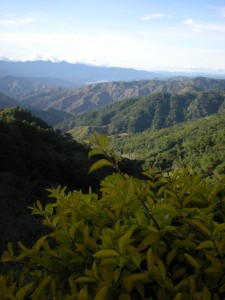Is it wise to travel by sea in the wake of a tropical typhoon? No, it is not. Circumstances beat intuition, however, and I found myself an unintentional victim of our unscrupulous Mother Nature.
Captivated by Karst: what to do without electricity in the tropics
If the treasure map leading you tell El Nido came with instructions, it would say: Go to Roxas. Take the dirt road north. Keep going. Your first stunning vista will confirm your arrival in the archipelago. Continue until the road ends at the sea.
Slowing Down in Sabang: a town in nine words
For five scheduled hours each day, electricity is available in Sabang. Their concrete oceanside pier also functions as a basketball court, community dance hall, and a place for the heavy surf to deposit a quarter ton of rocks every night. Staying in a bungalow on the southern beach runs about $10 per evening. Staying in the random, out-of-place luxury resort on the north beach will suck $250 a night from your wallet (on a discounted week).
A Filipino Foray in Five Senses: the incredible & the unbelievable
So what’s it like to travel through the countryside of the Philippines? The road quality varies from place to place, but otherwise the experience is much the same. Here are observations on the three hour journey from Puerto Princesa to Sabang via jeepney.
SENSE #1 – HEAR (SOUND)
I’m not going to lie. Diesel engines are loud! And when the jeepney’s windshield is permanently wedged open, the wind is loud, too. I could never trace the source of the forceful “cheep, cheeping” the vehicle made every time we slowed down or accelerated. And of course the horn goes off anytime the driver sights anything that can move on its own two/four legs (regardless of whether or not said creature is moving or just sitting). The sound seared into my memory, however, was a pig.
Sleeping With Strangers: what not to pack
I travel with about 12 or 13 kilos (roughly 24-26 pounds) on my back. If you are setting out on a travel adventure, there is NO REASON to fill up a backpack that is meant for a week-long hiking trip. This type of bag is intended to support survival completely independent of civilization for a week straight. If you are the type of person who is even a little bit tempted to fill one of these big bags,
Murphy’s Law Won Battles, Not War: Philippines airport secrets
“If it’s common sense and efficient… it ain’t happenin’ in the Philippines…” said I in a recent email. This isn’t entirely true, but it IS the rule.
Granted, the story I’m about to tell you involves some poor choices on my part. But this entry isn’t about my shortcomings, now is it?
Jeepney Karaoke: the short bus gets a new life
A riddle: 5 Norwegians, 6 Filipinos, 1 American, and a roving karaoke screen = a) an absolute blast, b) a broken camera, or c) both a and b.

The adorable Norwegian couple shares a song and a kiss. Stephen rocks the potentially awkward moment.
Yeah. You guessed. Yes, my camera fell from it’s self-timed perch and the lens would no longer retract. Yes, my judgement was clouded by Boracay rum and San Miguel Pilsen. Yes, I tried many a foggy folly and ultimately guaranteed my camera would never take another photo again. Yes, I had a totally fun night singing at the top of my lungs for three hours with a crowd of enthusiastic Norwegians and Filipinos.
I grew up with music — my grandmother teaching me children’s songs, piano lessons with my mom by my side, choreographing song-and-dance routines to perform anytime the family had guests…. and when we didn’t, I’d just go Broadway for my reflection in the French patio doors.
Baguio with My “Boyfriendâ€: absence feeds addiction
Time alone is good for the soul, in my humble opinion. When Pat and I went our separate ways at the Manila airport, we agreed that it would be a full-separation. One of the benefits of traveling alone is all the introspection prompted by down-time and no one to talk to but yourself. Yes, it can get lonely, but no pain, no gain! If we turned to the familiar company of our relationship via facebook, emails, and live chats when things got quiet, it would defeat half the purpose of setting out alone.
Of course, every self-introduction longer than five minutes involves an explanation of “my partner,” where he is, and why on earth we’re doing this crazy traveling apart thing. Once, as I struggled for words regarding why we don’t stay in touch, my companion offered, “Because when you get back together you wouldn’t have anything to talk about?” Ha! So far from the truth!
Chicken Sacrafices & the Love of My Life
I didn’t know that, before I could travel to see Pat, I’d have to partake in a chicken sacrifice. Pinikpikan is written about in the Lonely Planet guide and I’d given my local friends the Jema-style inquisition about it. From those sources, I gather that: 1) on the purely factual side — a chicken is beaten while alive so that it’s blood coagulates. Cook and serve. 2) On the “why” side — it is an offer made to God in hopes of protection in an endeavor (a long drive home for us). Beating the chicken somehow appeases the heavenly father and the bad spirits.
How it worked for me: We all went back to Cyril’s place.
How Do You Use the Scoop? (Toilets in a Foreign Land)
Admit it. At some (immature?) level, the tail end (ahem..) of the digestive process can be (uncomfortably?) funny. From the popular book Everyone Poops (“Birds do it, bees do it, kids with bended knees do it…” to fart jokes told by 8 year old boys and 80 year old men — this is a topic that gets laughed about.

Typical squat toilet found in Asia (haven’t seen one in the Philippines yet). They are actually really comfortable!
And while, “everyone poops,” there are very different rituals surrounding this (ahem..) regular process. The porcelain throne and toilet paper that reign supreme in the good old U.S.A. is not a worldwide combination








Twitter Facebook Google+ StumbleUpon Reddit Pinterest